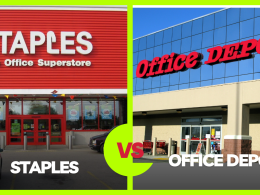Starting a printing business from home can be a great way to turn your passion for printing into a profitable business. However, starting any business can be challenging, and it’s essential to have a solid plan in place. This guide will provide a step-by-step overview of how to start a printing business at home, including information on equipment and software, legal requirements, marketing and advertising, finances, setting up a productive home office, sourcing materials, and scaling your business. (Also Read: How to Start a Handbag Business From Home)
Equipment and software
The first thing you should consider when beginning a printing business from home is to make a list of the hardware and software you’ll need to get started. The type of equipment and software you need will depend on the type of printing you plan to do. For example, if you plan to print t-shirts, you will need a heat press and a vinyl cutter. If you plan to print on paper, you will need a printer and a cutter. Some other equipment that you may need includes a computer, design software, and a camera.

When it comes to equipment and software, it’s essential to budget accordingly. Printing equipment and software can be expensive, so it’s important to research different options and find the best deal. You may also want to consider financing options, such as leasing or renting equipment, to help with the initial costs. It’s also important to consider the cost of maintenance and repairs, as well as the cost of ink or toner.
In addition to equipment and software, it’s important to have a good understanding of the printing process and the different types of printing available. This includes digital printing, screen printing, offset printing, and more. It’s important to research the different printing processes, as well as the materials they require and the end product they produce. This will help you determine which type of printing is the best fit for your business.
Legal Requirements
When starting a business, it’s essential to comply with all legal requirements. This includes registering your business and obtaining any necessary permits and licenses. You will also need to comply with zoning and other regulations. It’s best to consult with a lawyer or accountant to ensure that you are in compliance with all legal requirements. It’s also important to consider the insurance requirements for your business, such as liability insurance, as well as the requirement of registering for taxes.
Marketing and advertising
Marketing and advertising are essential for any business, and the printing business is no exception. Building a strong online presence is crucial, as many customers will find you through online search engines. You should also consider networking and collaborating with other businesses in your area. This can help you get your name out there and attract new customers.
In addition to building an online presence, it’s important to have a clear understanding of your target market. This includes identifying your ideal customer and understanding their needs and preferences. This will help you develop effective marketing and advertising strategies that will resonate with your target market.
Finances
Finances are an essential aspect of any business, and it’s important to budget accordingly when starting a printing business. This includes creating a budget, managing cash flow, and developing pricing strategies. It’s best to consult with a financial advisor to help you manage your finances effectively.
When creating a budget, it’s important to consider all of the costs associated with starting and running a printing business. This includes equipment and software costs, legal and regulatory costs, marketing and advertising costs, and more. It’s important to create a realistic budget that takes all of these costs into account.
Managing cash flow is also an important aspect of finances. This includes accurately tracking income and expenses, as well as forecasting future cash flow. It’s important to have a system in place to manage cash flow, such as invoicing and billing, to ensure that your business has the cash it needs to operate.
Pricing strategies are also an essential aspect of finances. This includes determining the cost of goods and services as well as setting prices that are competitive in the market. It’s important to consider factors such as production costs, market demand, and competition when setting prices.
Setting Up a Productive Home Office
Working from home can be challenging, and it’s essential to set up a productive home office. This includes considering space and layout, organizing and streamlining processes, and developing effective working-from-home strategies. It’s also important to have a dedicated space for your printing business to separate it from your personal life.
When setting up your home office, consider the type of equipment and software you will need and make sure that you have enough space to accommodate them. You should also think about the layout of your office and how you can organize your workspace to maximize efficiency. Organizing and streamlining processes will help you work more efficiently and increase productivity.
It’s also important to develop effective strategies for working from home. This includes setting clear boundaries between your work and personal lives, creating a schedule and sticking to it, and taking breaks when necessary. Additionally, it’s essential to have a comfortable and ergonomic setup to minimize any potential health risks associated with prolonged sitting or standing.
Sourcing Materials
When starting a printing business, it’s important to source materials from reliable suppliers. This includes finding suppliers that offer high-quality materials at a reasonable price. It’s also important to negotiate prices and establish long-term relationships with suppliers to ensure that you have a consistent supply of materials.
When sourcing materials, it’s important to consider factors such as quality, price, and lead times. You should also research different suppliers and compare their products and services to find the best fit for your business. It’s important to have a better relationship with your suppliers, as they can be a valuable resource for your business, providing you with information on new products, industry trends, and more.
Managing inventory is also an essential aspect of sourcing materials. This includes keeping accurate records of inventory levels and reordering materials when necessary. It’s important to have a system in place to track inventory and ensure that you always have enough materials on hand to meet customer demand. A good inventory management system will also help you reduce waste and lower costs.
Scaling your business
Once your printing business is up and running, it’s important to think about how you can scale it. This includes identifying opportunities for growth, hiring employees, and expanding your services and offerings. As your business grows, you might need to buy more tools and software or move to a bigger office.
It’s important to have a clear vision of where you want your business to go and to develop a plan to achieve it. This can include identifying new market opportunities, expanding your product line, or increasing your marketing and advertising efforts.
Hiring employees can help take some of the workloads off of you and can also bring fresh ideas and perspectives to the business. As your business grows, you may need to hire additional staff to help with tasks such as production, customer service, and sales. It’s important to carefully screen and select employees, as well as provide them with the necessary training and resources to perform their job effectively.
Expanding your services and offerings can also help to increase revenue and attract new customers. This can include adding new printing services, such as large-format printing or custom printing, or offering additional products, such as promotional items or packaging solutions. It’s important to research the market and identify opportunities for growth that align with your business’s strengths and capabilities.
Conclusion
Starting a printing business from home can be a great way to turn your passion for printing into a profitable business. However, it’s essential to have a solid plan in place and to be prepared for the challenges that come with starting any business. This guide has provided a step-by-step overview of how to start a printing business at home, including information on equipment and software, legal requirements, marketing and advertising, finances, setting up a productive home office, sourcing materials, and scaling your business.
It’s important to research and seeks professional advice to ensure that all legal, financial, and logistical aspects are covered. With the right plan in place, you can turn your dream of starting a printing business into a reality. (Also Read: The Role of Artificial Intelligence in Innovative Business Solutions)












